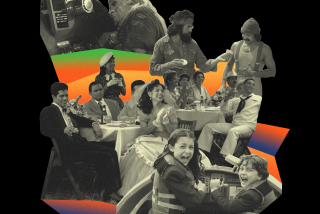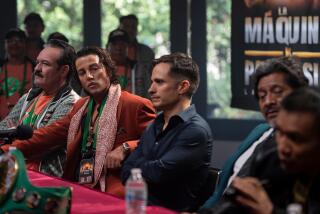Dora: The pint-sized superstar
The girl who helped change children’s TV wasn’t originally conceived as a fearless bilingual character. In fact, she wasn’t always a girl. In the original concept, she was a rabbit … a male rabbit.
But the creators finally fixed on doe-eyed Dora Marquez, who kicked off the first show with three simple words: “Hi, I’m Dora.” Dora began traveling through the jungle — speaking bits of Spanish along the way — and onto the nation’s television screens in August 2000. Now, in what seems like a blink of her big eyes, the eternal 7-year-old is preparing to celebrate 10 (¡diez!) years on the air.
Every morning brings a new adventure. At the beginning of each episode of “Dora the Explorer,” which airs weekdays at 8 a.m. on Nickelodeon, the Latina heroine and her best friend, Boots the monkey, are presented a problem. The adventurous duo, with the help of dependable Map, embark on a fun-filled journey where they solve simple math and word problems, meet friends and overcome various obstacles. All that shouting kids are doing at their TV screens? That comes when Dora asks her pint-sized viewers to help figure out the solutions with them. Dora also teaches viewers a few new Spanish words or phrases that are used throughout the episode.
The idea was to foster pride among Latino children and familiarity with Latino culture among English speakers, but only indirectly as part of an entertainment show.
“It was just about creating a show we thought kids would love,” said Chris Gifford, who created the series along with Valerie Walsh Valdes and Eric Weiner. “We didn’t begin to think how long it might go for.”
“She doesn’t just talk to kids,” Walsh Valdes said. “She engages them. She makes them part of her adventure. She’s their friend.” (Gifford had produced “Clarissa Explains it All,” on Nickelodeon and Weiner wrote for Canadian TV before the team came together on “Dora.”)
Amid these warm-hearted adventures, Dora became a pop-culture superstar, a lucrative franchise and a force that helped shift the globalized juvenile television landscape that has become increasingly multicultural and bilingual. Dora, in some eyes, also became a poster child for immigration and the target of anti-immigrant sentiment.
The animated series is now broadcast in more than 100 countries — it’s the No. 1-rated preschool show in many of them, including France — and dubbed in 30 languages, such as Russian, Mandarin and German, with Dora mostly teaching English (in some cases Spanish).
“What’s been innovative about the show is it wasn’t conceptualized or presented as a Latino-themed show,” said Chon Noriega, director of UCLA’s Chicano Studies Research Center. “It was an educational series for kids that happened to have a Latino girl as the lead character. And it didn’t shy away from having a character that spoke Spanish. That allowed it to do something that was very unique.”
“She’s not the first or the only Latina character on TV,” said Carlos Cortés, professor emeritus in history at UC Riverside and a consultant on the series. “But she’s probably the only one to be embraced by the world.... She came at the right time.”
As if the sports-loving gal couldn’t get any bigger, a Dora balloon debuted in the Macy’s Thanksgiving Day Parade in 2005. She has also been featured in a number of YouTube parodies, cranking it out to rapper Soulja Boy’s song “Crank That” and subbing as Alec Baldwin’s daughter after his infamous voice-mail leak. And a video began circulating recently showing what Leonardo DiCaprio’s sci-thriller “Inception” would have looked like had Dora starred in it.
“I had been hearing how big she was becoming during the third season,” Walsh Valdes said. “But, you know, we’re writing with our heads down. It wasn’t until I drove across country and was in very small towns, and I’d see ‘Dora the Explorer’ tchotchkes, that it began to hit me. It knocked me over when I was in Guatemala; I went to a place that was 100% Mayan and I saw a Dora piñata. It was a knockoff, but it was still pretty amazing to see the reach of her. It’s beyond us.”
In its first year, “Dora the Explorer,” averaged 1.1 million viewers ages 2 to 5 and 2 million total viewers, according the Nielsen Co. These days, “Dora” delivers an average of 1.4 million viewers ages 2 to 5 and 2.9 million total viewers, beating out competitors “Curious George” and “Sid the Science Kid” on PBS and Disney’s “ Mickey Mouse Clubhouse.” Over the years, the show has won a Peabody award for excellence, an NAACP Image award and Parents’ Choice awards, among others, and has received 16 Daytime Emmy nominations.
Dora’s pipsqueak voice and repetition of catchy words might have parents going a little nutty, but not enough to keep them from turning the brand into a cash-generating machine. From global live tours to video games and movies to backpacks and sippy cups, her sizable head and bowl haircut are plastered on every conceivable kind of merchandise. Nickelodeon estimates she’s generated more than $11 billion in retail sales.
“Dora isn’t just a show; she’s DVDs, clothes, lunchboxes,” said Karen Sternheimer, an associate professor of sociology at USC and author of “It’s Not the Media: The Truth About Pop Culture’s Influence on Children.” “Nickelodeon has been very savvy about getting their characters into kids’ lives through a number of different platforms. They’ve taken branding to another level.”
That level was tested last year when Viacom, the parent of Nickelodeon, partnered with Mattel to release the Dora Links doll, an older version of the intrepid girl. A “teaser” silhouette featuring a girl with long, flowing hair and a more angular figure circulated on the Web and had many parents in an uproar over her sexualization — a petition was launched by two child psychologists. “What’s next? Dora the fashionista with stylish purse and stilettos?” they wondered. The doll made its way to store shelves anyway.
But it wouldn’t be the only controversy the animated youngster would face; next, her life and immigration status would be scrutinized.
Several doctored mug shots — one depicting a battered and bruised Dora accused of illegally crossing the border — began circulating the Web earlier this year after passage of Arizona’s controversial immigration law.
“There’s a part of me that’s almost like her mom,” Walsh Valdes said, recalling the moment she saw the image. “I said, ‘Why would they drag her into this?’ It seemed totally inappropriate.... I feel very territorial about her, so when I see stuff like that, it’s hard for me to laugh.”
Dora’s origins
She’s a global star, but Dora has always been purposely a bit indistinct.
Brown Johnson, the Nickelodeon executive responsible for developing the program, said the thinking was: “If Dora wasn’t from a specific country, more people could identify with her. We wanted the broadest possible audience for her, so where she was from was not important.”
Even after her transformation from a cottontail to a girl, Dora was not envisioned as being Latina. Her original name was Tess. The idea for an ethnic rebirth sprang after Johnson attended an industry conference during which the underrepresentation of Latinos in media was discussed.
The 2000 census showed that Latino communities were the nation’s fastest growing — and the biggest five-year Latino age group is infants to preschoolers. Yet data have long shown that Latinos are underrepresented in prime-time TV: UCLA research found that 4% of prime-time’s regular characters in 2004 were Latino, while Latinos make up about 15% of the U.S. population.
For years, the main source for children’s multicultural TV was PBS’ “Sesame Street.” The ensemble show has a melting pot of characters and has featured a Puerto Rican family and a Mexican monster named Rosita. Dora’s “success really reflects a change in the media environment for children over the years,” Sternheimer said. “It’s a great reflection of the shifting multicultural nature of our society.”
Since “Dora,” the children’s TV landscape has embraced diversity. PBS Kids revamped “Dragon Tales” in 2005 to include Enrique, who is Colombian. “Jay Jay the Jet Plane” has added a bilingual plane named Lina. “Dora” also launched a spinoff, “Go Diego Go,” starring Dora’s 8-year-old cousin, in 2005. It’s one of Nickelodeon’s top-performing shows.
More than 300 people work to create “Dora the Explorer”: More than a dozen in New York work on the writing, research and music; an additional 50 or so are at the Nicktoons animation studio in Burbank; and there’s a crew of about 250 in Korea doing the full animation and coloring. Each show takes roughly a year to produce.
Schoolteachers, sociologists and historians are all brought in to advise on “Dora” episodes. More than 20 cultural consultants have worked on the show to make Dora’s world reflect a pan-Latino culture that’s not just tortillas and mariachi music, Johnson said. “It was important for us that Dora represented the idea that being multicultural was super cool,” she said.
Cortés, who’s serves as a cultural consultant on the show, said not giving Dora a specific heritage made that idea a reality. “Not knowing where she was from allowed her to be a source of pride for anyone of Latino background,” he said. “She’s more relatable if you don’t peg her down.”
But is such ambiguity a good thing?
“The show definitely homogenizes the many different origin groups that are comprised within the Latino ethnicity,” said Jody Vallejo, an assistant professor of sociology at USC. “So Latino children are getting a very broad view of who they are. At the same time, it does allow people from those different origins to make her their own character, to take ownership. For non-Latinos who watch the show, it makes Latinos more relatable. It demonstrates that bilingualism is not that bad. But it makes it seem like Latinos come from a monolithic culture.”
Such multiculturalism means that the writers need to choose Spanish words carefully: Not only do they have to be preschooler appropriate, but they also have to be universal, like azul (blue) or cuidado (watch out). “It couldn’t be a Spanish word that meant one thing in Mexico and something else in Peru,” Cortés said.
However, her influence isn’t limited to language empowerment. “Dora is symbolic because she pioneered this sense of embracing someone who is different than you are,” Cortés said. “It’s the one social message I hope comes across with Dora.”
To commemorate 10 years of exploring, a TV movie, “Dora’s Big Birthday Adventure,” will be shown on the network Aug. 15. Among its guest stars are Rosie Perez, Hector Elizondo and John Leguizamo.
“My kids grew up with that chica,” said Leguizamo, who also guest-starred in a 2005 episode as Capt. Pirate Piggy. “I’m probably helping my career having my name associated with hers.”
More to Read
The complete guide to home viewing
Get Screen Gab for everything about the TV shows and streaming movies everyone’s talking about.
You may occasionally receive promotional content from the Los Angeles Times.







